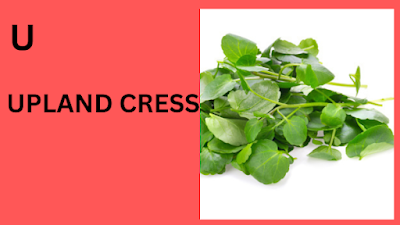Health Benefits of Eating Upland Cress.
Health Benefits of Eating Upland Cress.
Upland cress is one of the three Cress groups; all belong to the Brassicaceae family of plants. Used in ancient cultures for its medicinal qualities, find use in modern medicines for healing and prevention of diseases.
Upland Cress is a leafy vegetable with small to medium size plants with flat round leaves growing in rosettes and narrow stems, slender, light green and crisp. The leaves have a peppery, pungent flavour and taste stronger than Watercress.
There are three significant groups of cress: Watercress (Nasturtium offcinale), Garden cress (Lepidium satisvum) and Upland cress (Barberea Verna). And the plants are known as American Cress, Dryland Cress, and Garden Cress. All of them are grown in various parts of the world. They all belong to the Brassicaceae family. Upland cress is native to Southwestern Europe, currently growing in Asia, the US and Africa.
Upland cress and Watercress are lookalikes having similar nutrients and health benefits, as the latter grows in water.
South Africa produces it in Autumn and spring; it loves cooler weather. It is a close cousin of mustard leaves, cabbage and Arugula and is considered one of the oldest vegetables consumed by humans since its health benefits have been known since the olden days.
It is best suited for raw and cooked servings such as steaming, boiling, and sauteing. When fresh, the leaf can be thrown on salads, layered in sandwiches and wraps, and sauteed leaves can be used to top baked food and pizzas and blended into sauces, stews, and curries.
Nutrients.
Upland cress contains.
- Vitamins A, C and K.
- Vitamin B12,
- Minerals: magnesium, iron, manganese, calcium, and folate.
In comparison, it contains more vitamin C than oranges, more calcium than milk, more iron than spinach and more folate than bananas. What a wonder plant!
Health Benefits.
- This super healthy plant ranks at the top of superfood lists that keep you in top form.
- Used as in the olden days to prevent a vast range of ailments with modern herbal medicines recognising its blood cleansing and anti-inflammatory properties.
- Many herbalists recommend eating fresh leaves to alleviate eczema and cold symptoms such as runny nose due to its high concentration of vitamin C.
Research has shown that daily consumption of the upland cress reduces DNA damage in blood cells, which is the reason for cancer risks.
A special mustard oil in the plant called phenethyl Isothiocyanate (PEITC) has significant anticancer properties. This is also because of the elevated levels of vitamin C present.
Conclusion
Upland cress is one of the three Cress groups; all belong to the Brassicaceae family of plants. Used in ancient cultures for its medicinal qualities, find use in modern medicines for healing and prevention of diseases.
Do you use these plant leaves in your foods, and are they readily available where you live?
This post is for the letter U in the series of my A2Z blog posts, lasting for the entire month and is part of the A2Z Blog chatter challenge. To read earlier posts, click on these letters A B C D E F G H I J K L M N O P Q R S T
*


Comments
Post a Comment